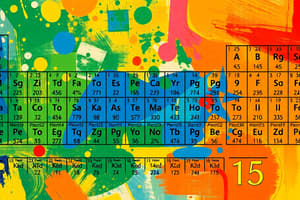Podcast
Questions and Answers
The number of protons present in the nucleus of an atom is known as the ______.
The number of protons present in the nucleus of an atom is known as the ______.
proton number
The atomic mass number (A) is equal to the number of ______ plus the number of neutrons.
The atomic mass number (A) is equal to the number of ______ plus the number of neutrons.
protons
The atomic mass number is used to distinguish between different ______ of the same element.
The atomic mass number is used to distinguish between different ______ of the same element.
isotopes
The atomic radius ______ from left to right across a period.
The atomic radius ______ from left to right across a period.
Electronegativity and ionization energy are related to the ______ and the number of electrons in the outermost energy level.
Electronegativity and ionization energy are related to the ______ and the number of electrons in the outermost energy level.
Periodic table trends are due to the increasing ______ and the shielding effect of inner electrons.
Periodic table trends are due to the increasing ______ and the shielding effect of inner electrons.
Flashcards are hidden until you start studying
Study Notes
Atomic Number and Atomic Mass Number
Proton Number (Atomic Number)
- The number of protons present in the nucleus of an atom
- Determines the identity of an element (e.g., hydrogen, carbon, oxygen)
- Each element has a unique atomic number (Z) that ranges from 1 (hydrogen) to 118 (oganesson)
- Atomic number determines the position of an element in the periodic table
Nucleon Number (Atomic Mass Number)
- The total number of protons and neutrons present in the nucleus of an atom
- Atomic mass number (A) = number of protons (Z) + number of neutrons (N)
- Atomic mass number is used to distinguish between different isotopes of the same element
- Isotopes have the same atomic number (Z) but differ in atomic mass number (A)
Periodic Table Trends
- Atomic radius: decreases from left to right across a period, increases down a group
- Electronegativity: increases from left to right across a period, decreases down a group
- Ionization energy: increases from left to right across a period, decreases down a group
- Electronegativity and ionization energy are related to the atomic number (Z) and the number of electrons in the outermost energy level
Note: Periodic table trends are due to the increasing nuclear charge and the shielding effect of inner electrons.
Studying That Suits You
Use AI to generate personalized quizzes and flashcards to suit your learning preferences.




